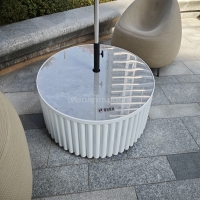Welcome to the website for landscape facilities products and knowledge.
How do landscape tables in outdoor art installations differ from functional furniture designs?
Landscape tables in outdoor art installations and functional furniture designs serve distinct purposes, blending creativity with practicality in unique ways. While both may share similar forms, their underlying intentions set them apart.
1. Purpose and Intent
Landscape tables in art installations prioritize aesthetic expression and conceptual meaning. They often challenge traditional functionality, serving as interactive sculptures or symbolic elements within a larger artistic narrative. Functional furniture, however, focuses on usability, comfort, and durability, designed to meet everyday needs.
2. Materials and Construction
Artistic landscape tables may use unconventional materials like weathered metal, reclaimed wood, or even ephemeral elements to evoke emotion or commentary. Functional furniture typically employs sturdy, weather-resistant materials like treated wood, aluminum, or synthetic composites to ensure longevity and practicality.
3. Interaction and Experience
Outdoor art tables invite engagement through thought-provoking designs, encouraging viewers to interpret their meaning. Functional furniture, such as park benches or picnic tables, emphasizes ergonomics and accessibility, prioritizing user comfort over artistic dialogue.
4. Context and Placement
Art installations often place landscape tables in curated environments to enhance their visual impact, while functional furniture integrates seamlessly into public or private spaces for practical use. The former disrupts, the latter accommodates.
Ultimately, the difference lies in their core objectives: art inspires, while furniture serves. Both, however, enrich outdoor spaces in their own ways.
Related search:

Recommendation
Round metal tube border design table with tempered glass or granite countertop on the top.